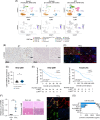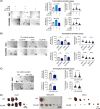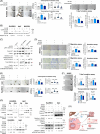Secreted lumican from the tumor microenvironment potentiates HCC stemness and progression
- PMID: 40824257
- PMCID: PMC12363449
- DOI: 10.1097/HC9.0000000000000778
Secreted lumican from the tumor microenvironment potentiates HCC stemness and progression
Abstract
Background: Extracellular matrix proteins are tightly linked to cancer progression. HCC frequently arises from chronic liver diseases with varying degrees of parenchymal fibrosis. Herein, we aimed to investigate the roles of secreted lumican, an extracellular matrix proteoglycan, in HCC.
Methods: Lumican expression in clinical liver tissue samples was analyzed. In vitro and in vivo functional assays were performed with cell lines. Co-culture systems were adopted to examine the roles of lumican in the interaction between HCC cells and liver fibroblasts. Downstream mechanisms were interrogated by transcriptomic and proteomic profiling.
Results: Analyses of single-cell RNA-sequencing datasets collectively revealed high lumican expression in liver fibroblasts. Lumican expression was elevated in liver tissues with advanced fibrosis, and a higher lumican level in the non-tumor liver tissue was a poor prognosticator of HCC. Functionally, recombinant human lumican (rhLUM) promoted migration, invasion, and self-renewal of HCC cells, and enhanced angiogenesis in vitro. These effects were abrogated by anti-lumican antibody. The paracrine actions of lumican in the interplay between HCC cells and liver fibroblasts were supported with co-culture models, in which lumican was manipulated by genetic or antibody approaches. In vivo, recombinant lumican promoted neovascularization and tumor incidence. Profiling results revealed the enrichment of Wnt signaling, and mechanistic dissection uncovered the crosstalk between PI3K/AKT and Wnt/β-catenin pathways in rhLUM-treated HCC cells.
Conclusions: Secreted lumican promotes HCC self-renewal, tumor initiation, and progression by activating the AKT/GSK3β/β-catenin signaling cascade. Targeting secreted lumican is a potential therapeutic strategy for HCC.
Keywords: extracellular matrix proteins; fibroblasts; liver cancer.
Copyright © 2025 The Author(s). Published by Wolters Kluwer Health, Inc. on behalf of the American Association for the Study of Liver Diseases.
Conflict of interest statement
The authors have no conflicts to report.
Figures






Similar articles
-
Tumor-Associated Neutrophils Recruit Macrophages and T-Regulatory Cells to Promote Progression of Hepatocellular Carcinoma and Resistance to Sorafenib.Gastroenterology. 2016 Jun;150(7):1646-1658.e17. doi: 10.1053/j.gastro.2016.02.040. Epub 2016 Feb 26. Gastroenterology. 2016. PMID: 26924089
-
Nuclear factor IA-mediated transcriptional regulation of crystallin αB inhibits hepatocellular carcinoma progression.Mol Clin Oncol. 2025 Jun 20;23(2):72. doi: 10.3892/mco.2025.2867. eCollection 2025 Aug. Mol Clin Oncol. 2025. PMID: 40599718 Free PMC article.
-
IGF2 Is Up-regulated by Epigenetic Mechanisms in Hepatocellular Carcinomas and Is an Actionable Oncogene Product in Experimental Models.Gastroenterology. 2016 Dec;151(6):1192-1205. doi: 10.1053/j.gastro.2016.09.001. Epub 2016 Sep 7. Gastroenterology. 2016. PMID: 27614046
-
Contrast-enhanced ultrasound using SonoVue® (sulphur hexafluoride microbubbles) compared with contrast-enhanced computed tomography and contrast-enhanced magnetic resonance imaging for the characterisation of focal liver lesions and detection of liver metastases: a systematic review and cost-effectiveness analysis.Health Technol Assess. 2013 Apr;17(16):1-243. doi: 10.3310/hta17160. Health Technol Assess. 2013. PMID: 23611316 Free PMC article.
-
Systemic treatments for metastatic cutaneous melanoma.Cochrane Database Syst Rev. 2018 Feb 6;2(2):CD011123. doi: 10.1002/14651858.CD011123.pub2. Cochrane Database Syst Rev. 2018. PMID: 29405038 Free PMC article.
References
-
- Qi M, Chen Y, Zhang GQ, Meng YJ, Zhao FL, Wang J, et al. Clinical significance of preoperative liver stiffness measurements in primary HBV-positive hepatocellular carcinoma. Future Oncol. 2017;13:2799–2810. - PubMed
LinkOut - more resources
Full Text Sources

